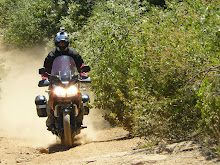Some thoughts and conclusions from my 2,000 mile solo motorcycle ride to Death Valley, Grand Canyon, Zion and Valley of Fire...
Equipment:
Motorbike: The '09 Suzuki DL650 performed flawlessly. Had lots of guys question the 650 choice, and could have gone with the 1k version (for an additional $3K). But I never felt compromised, not going up the hills or across the long interstate stretches. That 650cc engine is quite happy running along at 80+mph all day long across the desert. The seat was extremely comfortable, and with the Alaskan Leather sheepskin, it was really quite good.
The Givi E52 topcase, and E21 sidecases worked great, and are sturdy kit.
Good quality riding gear, including armored jacket/pants with liners I feel are important. They saved me in the snow and cold conditions, and gave me protection from the high-speed blasts of the interstate. They also provide additional safety. They're worth the money.
The inexpensive SevenZeroSeven helmet worked very well; all day comfort and ventilation. Too bad I dropped it twice.
I fashioned a portable kickstand plate, to help in the dirt from having the bike tip over. Its just some spare aluminum I had on hand that I filed the edges so it didn't cut my tankbag. I kept it in one of the outside pockets for convenience. It worked great, and saved the bike in the soft stuff while I was taking pictures. I'm going to drill small hole in it, and tie a jute string to it, so I can retrieve it while I'm mounted on the seat.
I packed all sorts of tools, tiny air compressor, tire plug kit, 1st aid gear, and much more. Luckily didn't need any of that on this trip. I did find that if I prioritized things in the luggage, it helped speed up the stops and prep:
Most used items in tank bag, right in front of me. (camera, sunscreen, etc.)
Food, water, cold weather gear go on topcase, as it's next easiest to access.
Then less used items on the right sidecase (opposite the kickstand), such as
extra water, chain lube, nofog spray). These are things I can take care of at regular stops, like overnight.
Left sidecase held air compressor and camping cooking pots, pack-stove, fuel.
That way, at stops overnight, where the gear gets taken off the bike anyway, I use the things I don't need while I'm driving. Took a few tries to finally figure out the things I need most often in the daytime while riding.
Same goes for strapping down the luggage. At first, took quite a while, but then you remember what works best, and get a system down. The flat bungie cords from Walmart, 2 for $4, work great. Get several pair in different lengths.
Earplugs were important to reduce the windnoise and fatigue. I wore them all the time.
The tank-mounted GPS from my car worked great. I couldn't hear the voice announcements in the freeway, but it was visible enough that it really helped. And the automatic rerouting feature came in handy.
While I had camping gear with me, I stayed in hotels each night. It was nice safety net to have the gear, and though I had intentions of using it, those areas didn't pan out for various reasons and the luxury of a hot shower at the end of a long day's ride was really great.
Cell coverage was pretty good wherever there was civilization with the exception of Death Valley, CA.; don't expect any coverage there from Bishop until you get to Pahrump.
Friday, April 24, 2009
Subscribe to:
Post Comments (Atom)





No comments:
Post a Comment